github.com/kaituanwang/hyperledger@v2.0.1+incompatible/docs/source/peers/peers.md (about) 1 # Peers 2 3 A blockchain network is comprised primarily of a set of *peer nodes* (or, simply, *peers*). 4 Peers are a fundamental element of the network because they host ledgers and smart 5 contracts. Recall that a ledger immutably records all the transactions generated 6 by smart contracts (which in Hyperledger Fabric are contained in a *chaincode*, 7 more on this later). Smart contracts and ledgers are used to encapsulate the 8 shared *processes* and shared *information* in a network, respectively. These 9 aspects of a peer make them a good starting point to understand a Fabric network. 10 11 Other elements of the blockchain network are of course important: ledgers and 12 smart contracts, orderers, policies, channels, applications, organizations, 13 identities, and membership, and you can read more about them in their own 14 dedicated sections. This section focusses on peers, and their relationship to those 15 other elements in a Fabric network. 16 17 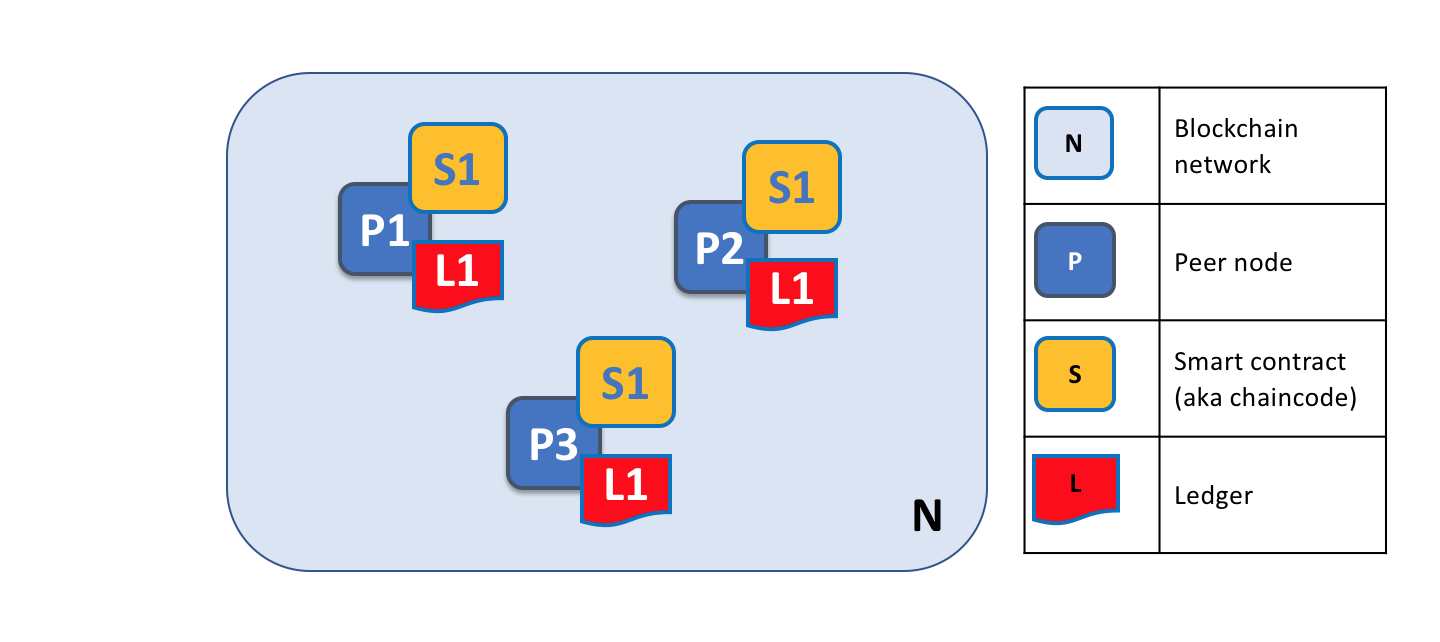 18 19 *A blockchain network is comprised of peer nodes, each of which can hold copies 20 of ledgers and copies of smart contracts. In this example, the network N 21 consists of peers P1, P2 and P3, each of which maintain their own instance of 22 the distributed ledger L1. P1, P2 and P3 use the same chaincode, S1, to access 23 their copy of that distributed ledger*. 24 25 Peers can be created, started, stopped, reconfigured, and even deleted. They 26 expose a set of APIs that enable administrators and applications to interact 27 with the services that they provide. We'll learn more about these services in 28 this section. 29 30 ### A word on terminology 31 32 Fabric implements **smart contracts** with a technology concept it calls 33 **chaincode** --- simply a piece of code that accesses the ledger, written in 34 one of the supported programming languages. In this topic, we'll usually use the 35 term **chaincode**, but feel free to read it as **smart contract** if you're 36 more used to that term. It's the same thing! If you want to learn more about 37 chaincode and smart contracts, check out our [documentation on smart contracts 38 and chaincode](../smartcontract/smartcontract.html). 39 40 ## Ledgers and Chaincode 41 42 Let's look at a peer in a little more detail. We can see that it's the peer that 43 hosts both the ledger and chaincode. More accurately, the peer actually hosts 44 *instances* of the ledger, and *instances* of chaincode. Note that this provides 45 a deliberate redundancy in a Fabric network --- it avoids single points of 46 failure. We'll learn more about the distributed and decentralized nature of a 47 blockchain network later in this section. 48 49 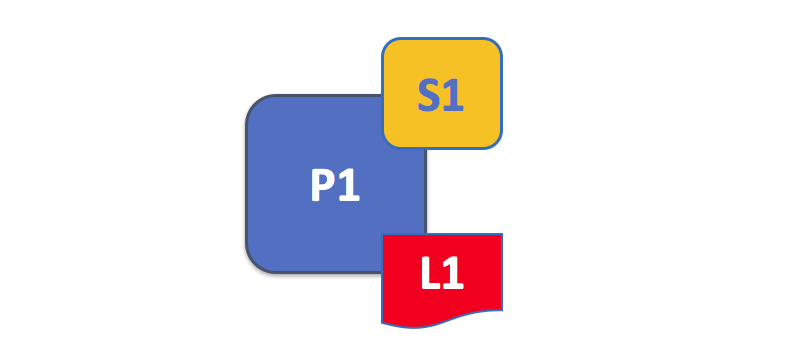 50 51 *A peer hosts instances of ledgers and instances of chaincodes. In this example, 52 P1 hosts an instance of ledger L1 and an instance of chaincode S1. There 53 can be many ledgers and chaincodes hosted on an individual peer.* 54 55 Because a peer is a *host* for ledgers and chaincodes, applications and 56 administrators must interact with a peer if they want to access these resources. 57 That's why peers are considered the most fundamental building blocks of a 58 Fabric network. When a peer is first created, it has neither ledgers nor 59 chaincodes. We'll see later how ledgers get created, and how chaincodes get 60 installed, on peers. 61 62 ### Multiple Ledgers 63 64 A peer is able to host more than one ledger, which is helpful because it allows 65 for a flexible system design. The simplest configuration is for a peer to manage a 66 single ledger, but it's absolutely appropriate for a peer to host two or more 67 ledgers when required. 68 69  70 71 *A peer hosting multiple ledgers. Peers host one or more ledgers, and each 72 ledger has zero or more chaincodes that apply to them. In this example, we 73 can see that the peer P1 hosts ledgers L1 and L2. Ledger L1 is accessed using 74 chaincode S1. Ledger L2 on the other hand can be accessed using chaincodes S1 and S2.* 75 76 Although it is perfectly possible for a peer to host a ledger instance without 77 hosting any chaincodes which access that ledger, it's rare that peers are configured 78 this way. The vast majority of peers will have at least one chaincode installed 79 on it which can query or update the peer's ledger instances. It's worth 80 mentioning in passing that, whether or not users have installed chaincodes for use by 81 external applications, peers also have special **system chaincodes** that are 82 always present. These are not discussed in detail in this topic. 83 84 ### Multiple Chaincodes 85 86 There isn't a fixed relationship between the number of ledgers a peer has and 87 the number of chaincodes that can access that ledger. A peer might have 88 many chaincodes and many ledgers available to it. 89 90  91 92 *An example of a peer hosting multiple chaincodes. Each ledger can have 93 many chaincodes which access it. In this example, we can see that peer P1 94 hosts ledgers L1 and L2, where L1 is accessed by chaincodes S1 and S2, and 95 L2 is accessed by S1 and S3. We can see that S1 can access both L1 and L2.* 96 97 We'll see a little later why the concept of **channels** in Fabric is important 98 when hosting multiple ledgers or multiple chaincodes on a peer. 99 100 ## Applications and Peers 101 102 We're now going to show how applications interact with peers to access the 103 ledger. Ledger-query interactions involve a simple three-step dialogue between 104 an application and a peer; ledger-update interactions are a little more 105 involved, and require two extra steps. We've simplified these steps a little to 106 help you get started with Fabric, but don't worry --- what's most important to 107 understand is the difference in application-peer interactions for ledger-query 108 compared to ledger-update transaction styles. 109 110 Applications always connect to peers when they need to access ledgers and 111 chaincodes. The Fabric Software Development Kit (SDK) makes this 112 easy for programmers --- its APIs enable applications to connect to peers, invoke 113 chaincodes to generate transactions, submit transactions to the network that 114 will get ordered, validated and committed to the distributed ledger, and receive 115 events when this process is complete. 116 117 Through a peer connection, applications can execute chaincodes to query or 118 update a ledger. The result of a ledger query transaction is returned 119 immediately, whereas ledger updates involve a more complex interaction between 120 applications, peers and orderers. Let's investigate this in a little more detail. 121 122 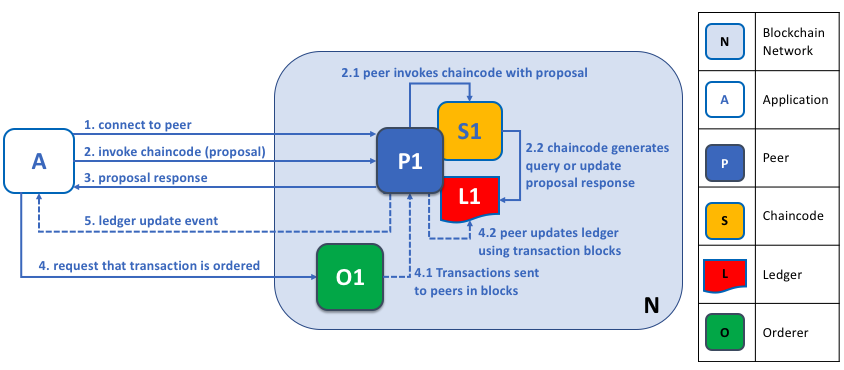 123 124 *Peers, in conjunction with orderers, ensure that the ledger is kept up-to-date 125 on every peer. In this example, application A connects to P1 and invokes 126 chaincode S1 to query or update the ledger L1. P1 invokes S1 to generate a 127 proposal response that contains a query result or a proposed ledger update. 128 Application A receives the proposal response and, for queries, 129 the process is now complete. For updates, A builds a transaction 130 from all of the responses, which it sends to O1 for ordering. O1 collects 131 transactions from across the network into blocks, and distributes these to all 132 peers, including P1. P1 validates the transaction before committing to L1. Once L1 133 is updated, P1 generates an event, received by A, to signify completion.* 134 135 A peer can return the results of a query to an application immediately since 136 all of the information required to satisfy the query is in the peer's local copy of 137 the ledger. Peers never consult with other peers in order to respond to a query from 138 an application. Applications can, however, connect to one or more peers to issue 139 a query; for example, to corroborate a result between multiple peers, or 140 retrieve a more up-to-date result from a different peer if there's a suspicion 141 that information might be out of date. In the diagram, you can see that ledger 142 query is a simple three-step process. 143 144 An update transaction starts in the same way as a query transaction, but has two 145 extra steps. Although ledger-updating applications also connect to peers to 146 invoke a chaincode, unlike with ledger-querying applications, an individual peer 147 cannot perform a ledger update at this time, because other peers must first 148 agree to the change --- a process called **consensus**. Therefore, peers return 149 to the application a **proposed** update --- one that this peer would apply 150 subject to other peers' prior agreement. The first extra step --- step four --- 151 requires that applications send an appropriate set of matching proposed updates 152 to the entire network of peers as a transaction for commitment to their 153 respective ledgers. This is achieved by the application by using an **orderer** to 154 package transactions into blocks, and distributing them to the entire network of 155 peers, where they can be verified before being applied to each peer's local copy 156 of the ledger. As this whole ordering processing takes some time to complete 157 (seconds), the application is notified asynchronously, as shown in step five. 158 159 Later in this section, you'll learn more about the detailed nature of this 160 ordering process --- and for a really detailed look at this process see the 161 [Transaction Flow](../txflow.html) topic. 162 163 ## Peers and Channels 164 165 Although this section is about peers rather than channels, it's worth spending a 166 little time understanding how peers interact with each other, and with applications, 167 via *channels* --- a mechanism by which a set of components within a blockchain 168 network can communicate and transact *privately*. 169 170 These components are typically peer nodes, orderer nodes and applications and, 171 by joining a channel, they agree to collaborate to collectively share and 172 manage identical copies of the ledger associated with that channel. Conceptually, you can 173 think of channels as being similar to groups of friends (though the members of a 174 channel certainly don't need to be friends!). A person might have several groups 175 of friends, with each group having activities they do together. These groups 176 might be totally separate (a group of work friends as compared to a group of 177 hobby friends), or there can be some crossover between them. Nevertheless, each group 178 is its own entity, with "rules" of a kind. 179 180 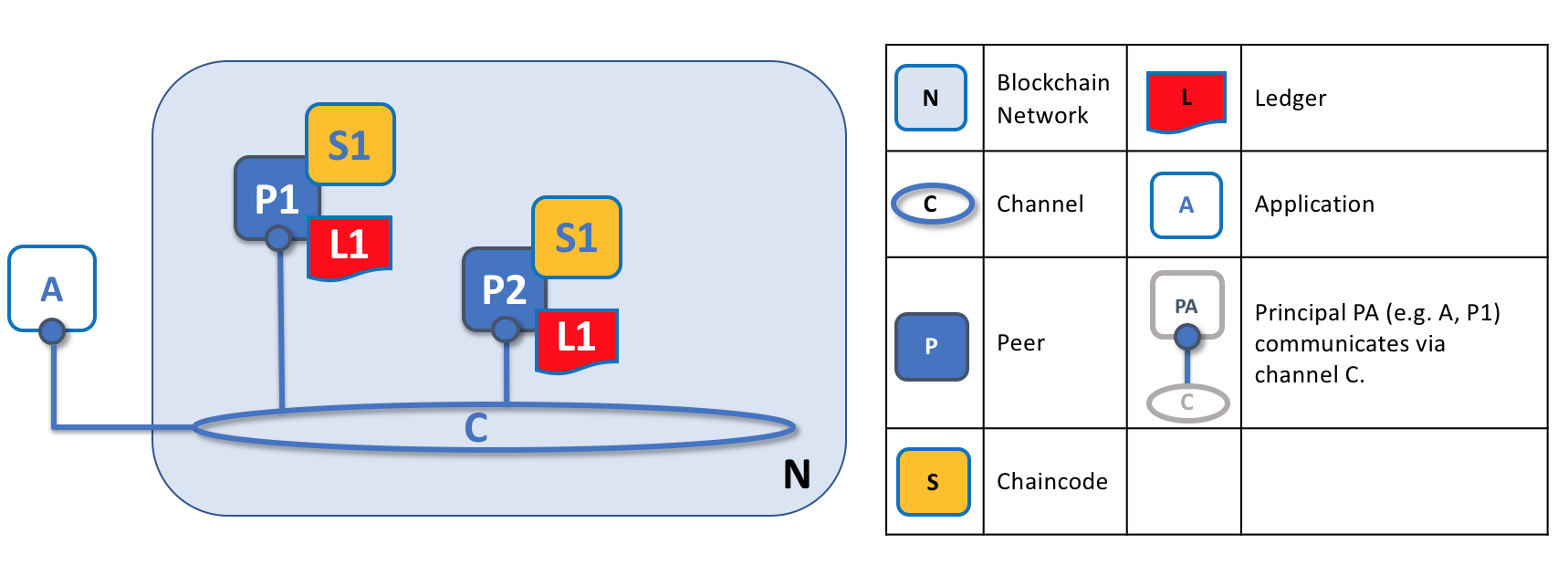 181 182 *Channels allow a specific set of peers and applications to communicate with 183 each other within a blockchain network. In this example, application A can 184 communicate directly with peers P1 and P2 using channel C. You can think of the 185 channel as a pathway for communications between particular applications and 186 peers. (For simplicity, orderers are not shown in this diagram, but must be 187 present in a functioning network.)* 188 189 We see that channels don't exist in the same way that peers do --- it's more 190 appropriate to think of a channel as a logical structure that is formed by a 191 collection of physical peers. *It is vital to understand this point --- peers 192 provide the control point for access to, and management of, channels*. 193 194 ## Peers and Organizations 195 196 Now that you understand peers and their relationship to ledgers, chaincodes 197 and channels, you'll be able to see how multiple organizations come together to 198 form a blockchain network. 199 200 Blockchain networks are administered by a collection of organizations rather 201 than a single organization. Peers are central to how this kind of distributed 202 network is built because they are owned by --- and are the connection points to 203 the network for --- these organizations. 204 205 <a name="Peer8"></a> 206  207 208 *Peers in a blockchain network with multiple organizations. The blockchain 209 network is built up from the peers owned and contributed by the different 210 organizations. In this example, we see four organizations contributing eight 211 peers to form a network. The channel C connects five of these peers in the 212 network N --- P1, P3, P5, P7 and P8. The other peers owned by these 213 organizations have not been joined to this channel, but are typically joined to 214 at least one other channel. Applications that have been developed by a 215 particular organization will connect to their own organization's peers as well 216 as those of different organizations. Again, 217 for simplicity, an orderer node is not shown in this diagram.* 218 219 It's really important that you can see what's happening in the formation of a 220 blockchain network. *The network is both formed and managed by the multiple 221 organizations who contribute resources to it.* Peers are the resources that 222 we're discussing in this topic, but the resources an organization provides are 223 more than just peers. There's a principle at work here --- the network literally 224 does not exist without organizations contributing their individual resources to 225 the collective network. Moreover, the network grows and shrinks with the 226 resources that are provided by these collaborating organizations. 227 228 You can see that (other than the ordering service) there are no centralized 229 resources --- in the [example above](#Peer8), the network, **N**, would not exist 230 if the organizations did not contribute their peers. This reflects the fact that 231 the network does not exist in any meaningful sense unless and until 232 organizations contribute the resources that form it. Moreover, the network does 233 not depend on any individual organization --- it will continue to exist as long 234 as one organization remains, no matter which other organizations may come and 235 go. This is at the heart of what it means for a network to be decentralized. 236 237 Applications in different organizations, as in the [example above](#Peer8), may 238 or may not be the same. That's because it's entirely up to an organization as to how 239 its applications process their peers' copies of the ledger. This means that both 240 application and presentation logic may vary from organization to organization 241 even though their respective peers host exactly the same ledger data. 242 243 Applications connect either to peers in their organization, or peers in another 244 organization, depending on the nature of the ledger interaction that's required. 245 For ledger-query interactions, applications typically connect to their own 246 organization's peers. For ledger-update interactions, we'll see later why 247 applications need to connect to peers representing *every* organization that is 248 required to endorse the ledger update. 249 250 ## Peers and Identity 251 252 Now that you've seen how peers from different organizations come together to 253 form a blockchain network, it's worth spending a few moments understanding how 254 peers get assigned to organizations by their administrators. 255 256 Peers have an identity assigned to them via a digital certificate from a 257 particular certificate authority. You can read lots more about how X.509 258 digital certificates work elsewhere in this guide but, for now, think of a 259 digital certificate as being like an ID card that provides lots of verifiable 260 information about a peer. *Each and every peer in the network is assigned a 261 digital certificate by an administrator from its owning organization*. 262 263 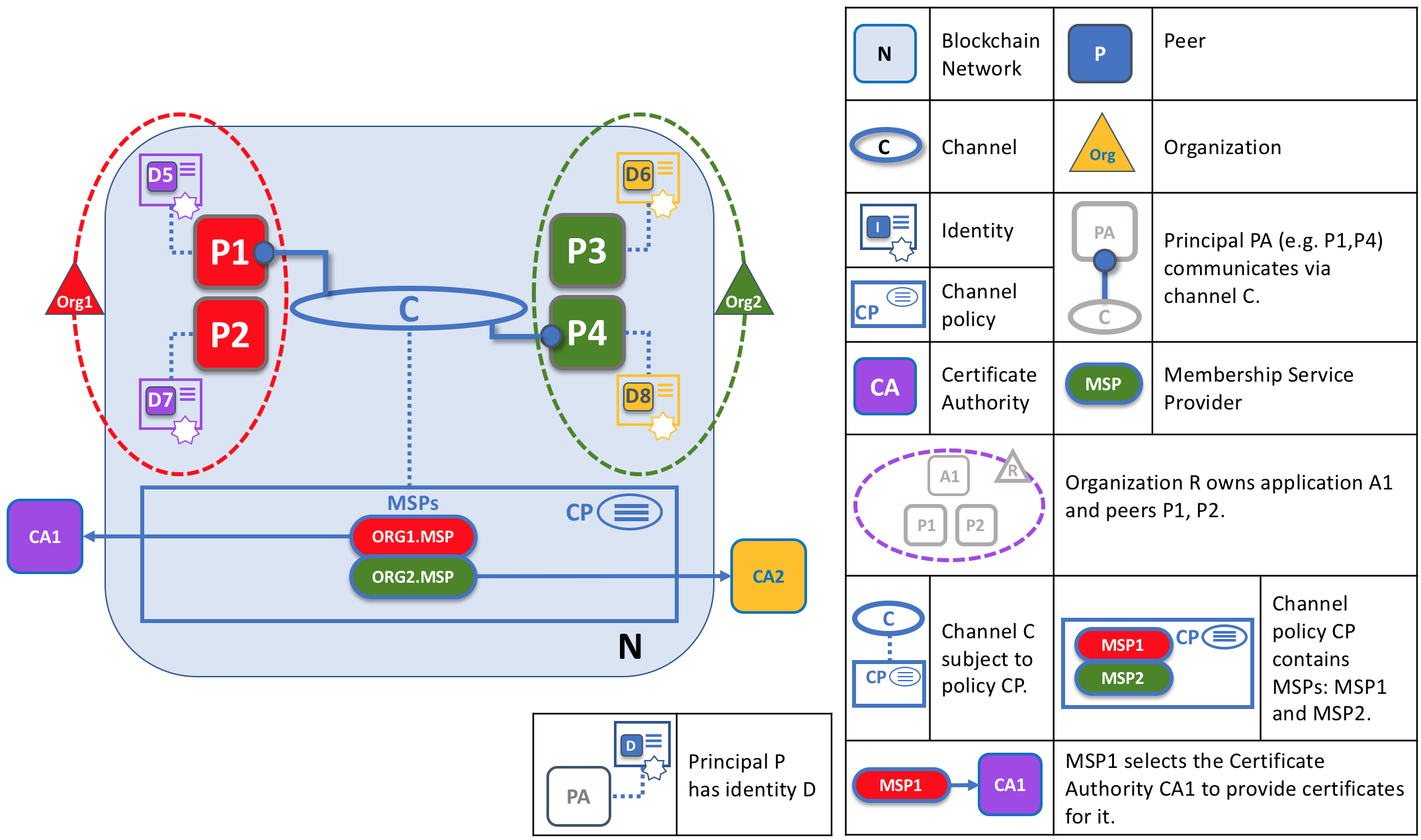 264 265 *When a peer connects to a channel, its digital certificate identifies its 266 owning organization via a channel MSP. In this example, P1 and P2 have 267 identities issued by CA1. Channel C determines from a policy in its channel 268 configuration that identities from CA1 should be associated with Org1 using 269 ORG1.MSP. Similarly, P3 and P4 are identified by ORG2.MSP as being part of 270 Org2.* 271 272 Whenever a peer connects using a channel to a blockchain network, *a policy in 273 the channel configuration uses the peer's identity to determine its 274 rights.* The mapping of identity to organization is provided by a component 275 called a *Membership Service Provider* (MSP) --- it determines how a peer gets 276 assigned to a specific role in a particular organization and accordingly gains 277 appropriate access to blockchain resources. Moreover, a peer can be owned only 278 by a single organization, and is therefore associated with a single MSP. We'll 279 learn more about peer access control later in this section, and there's an entire 280 section on MSPs and access control policies elsewhere in this guide. But for now, 281 think of an MSP as providing linkage between an individual identity and a 282 particular organizational role in a blockchain network. 283 284 To digress for a moment, peers as well as *everything that interacts with a 285 blockchain network acquire their organizational identity from their digital 286 certificate and an MSP*. Peers, applications, end users, administrators and 287 orderers must have an identity and an associated MSP if they want to interact 288 with a blockchain network. *We give a name to every entity that interacts with 289 a blockchain network using an identity --- a principal.* You can learn lots 290 more about principals and organizations elsewhere in this guide, but for now 291 you know more than enough to continue your understanding of peers! 292 293 Finally, note that it's not really important where the peer is physically 294 located --- it could reside in the cloud, or in a data centre owned by one 295 of the organizations, or on a local machine --- it's the digital certificate 296 associated with it that identifies it as being owned by a particular organization. 297 In our example above, P3 could be hosted in Org1's data center, but as long as the 298 digital certificate associated with it is issued by CA2, then it's owned by 299 Org2. 300 301 ## Peers and Orderers 302 303 We've seen that peers form the basis for a blockchain network, hosting ledgers 304 and smart contracts which can be queried and updated by peer-connected applications. 305 However, the mechanism by which applications and peers interact with each other 306 to ensure that every peer's ledger is kept consistent with each other is mediated 307 by special nodes called *orderers*, and it's to these nodes we now turn our 308 attention. 309 310 An update transaction is quite different from a query transaction because a single 311 peer cannot, on its own, update the ledger --- updating requires the consent of other 312 peers in the network. A peer requires other peers in the network to approve a 313 ledger update before it can be applied to a peer's local ledger. This process is 314 called *consensus*, which takes much longer to complete than a simple query. But when 315 all the peers required to approve the transaction do so, and the transaction is 316 committed to the ledger, peers will notify their connected applications that the 317 ledger has been updated. You're about to be shown a lot more detail about how 318 peers and orderers manage the consensus process in this section. 319 320 Specifically, applications that want to update the ledger are involved in a 321 3-phase process, which ensures that all the peers in a blockchain network keep 322 their ledgers consistent with each other. 323 324 * In the first phase, applications work with a subset of *endorsing peers*, each of 325 which provide an endorsement of the proposed ledger update to the application, 326 but do not apply the proposed update to their copy of the ledger. 327 * In the second phase, these separate endorsements are collected together 328 as transactions and packaged into blocks. 329 * In the third and final phase, these blocks are distributed back to every peer where 330 each transaction is validated before being committed to that peer's copy of the ledger. 331 332 As you will see, orderer nodes are central to this process, so let's 333 investigate in a little more detail how applications and peers use orderers to 334 generate ledger updates that can be consistently applied to a distributed, 335 replicated ledger. 336 337 ### Phase 1: Proposal 338 339 Phase 1 of the transaction workflow involves an interaction between an 340 application and a set of peers --- it does not involve orderers. Phase 1 is only 341 concerned with an application asking different organizations' endorsing peers to 342 agree to the results of the proposed chaincode invocation. 343 344 To start phase 1, applications generate a transaction proposal which they send 345 to each of the required set of peers for endorsement. Each of these *endorsing peers* then 346 independently executes a chaincode using the transaction proposal to 347 generate a transaction proposal response. It does not apply this update to the 348 ledger, but rather simply signs it and returns it to the application. Once the 349 application has received a sufficient number of signed proposal responses, 350 the first phase of the transaction flow is complete. Let's examine this phase in 351 a little more detail. 352 353  354 355 *Transaction proposals are independently executed by peers who return endorsed 356 proposal responses. In this example, application A1 generates transaction T1 357 proposal P which it sends to both peer P1 and peer P2 on channel C. P1 executes 358 S1 using transaction T1 proposal P generating transaction T1 response R1 which 359 it endorses with E1. Independently, P2 executes S1 using transaction T1 360 proposal P generating transaction T1 response R2 which it endorses with E2. 361 Application A1 receives two endorsed responses for transaction T1, namely E1 362 and E2.* 363 364 Initially, a set of peers are chosen by the application to generate a set of 365 proposed ledger updates. Which peers are chosen by the application? Well, that 366 depends on the *endorsement policy* (defined for a chaincode), which defines 367 the set of organizations that need to endorse a proposed ledger change before it 368 can be accepted by the network. This is literally what it means to achieve 369 consensus --- every organization who matters must have endorsed the proposed 370 ledger change *before* it will be accepted onto any peer's ledger. 371 372 A peer endorses a proposal response by adding its digital signature, and signing 373 the entire payload using its private key. This endorsement can be subsequently 374 used to prove that this organization's peer generated a particular response. In 375 our example, if peer P1 is owned by organization Org1, endorsement E1 376 corresponds to a digital proof that "Transaction T1 response R1 on ledger L1 has 377 been provided by Org1's peer P1!". 378 379 Phase 1 ends when the application receives signed proposal responses from 380 sufficient peers. We note that different peers can return different and 381 therefore inconsistent transaction responses to the application *for the same 382 transaction proposal*. It might simply be that the result was generated at 383 different times on different peers with ledgers at different states, in which 384 case an application can simply request a more up-to-date proposal response. Less 385 likely, but much more seriously, results might be different because the chaincode 386 is *non-deterministic*. Non-determinism is the enemy of chaincodes 387 and ledgers and if it occurs it indicates a serious problem with the proposed 388 transaction, as inconsistent results cannot, obviously, be applied to ledgers. 389 An individual peer cannot know that their transaction result is 390 non-deterministic --- transaction responses must be gathered together for 391 comparison before non-determinism can be detected. (Strictly speaking, even this 392 is not enough, but we defer this discussion to the transaction section, where 393 non-determinism is discussed in detail.) 394 395 At the end of phase 1, the application is free to discard inconsistent 396 transaction responses if it wishes to do so, effectively terminating the 397 transaction workflow early. We'll see later that if an application tries to use 398 an inconsistent set of transaction responses to update the ledger, it will be 399 rejected. 400 401 ### Phase 2: Ordering and packaging transactions into blocks 402 403 The second phase of the transaction workflow is the packaging phase. The orderer 404 is pivotal to this process --- it receives transactions containing endorsed 405 transaction proposal responses from many applications, and orders the 406 transactions into blocks. For more details about the 407 ordering and packaging phase, check out our 408 [conceptual information about the ordering phase](../orderer/ordering_service.html#phase-two-ordering-and-packaging-transactions-into-blocks). 409 410 ### Phase 3: Validation and commit 411 412 At the end of phase 2, we see that orderers have been responsible for the simple 413 but vital processes of collecting proposed transaction updates, ordering them, 414 and packaging them into blocks, ready for distribution to the peers. 415 416 The final phase of the transaction workflow involves the distribution and 417 subsequent validation of blocks from the orderer to the peers, where they can be 418 committed to the ledger. Specifically, at each peer, every transaction within a 419 block is validated to ensure that it has been consistently endorsed by all 420 relevant organizations before it is committed to the ledger. Failed transactions 421 are retained for audit, but are not committed to the ledger. 422 423 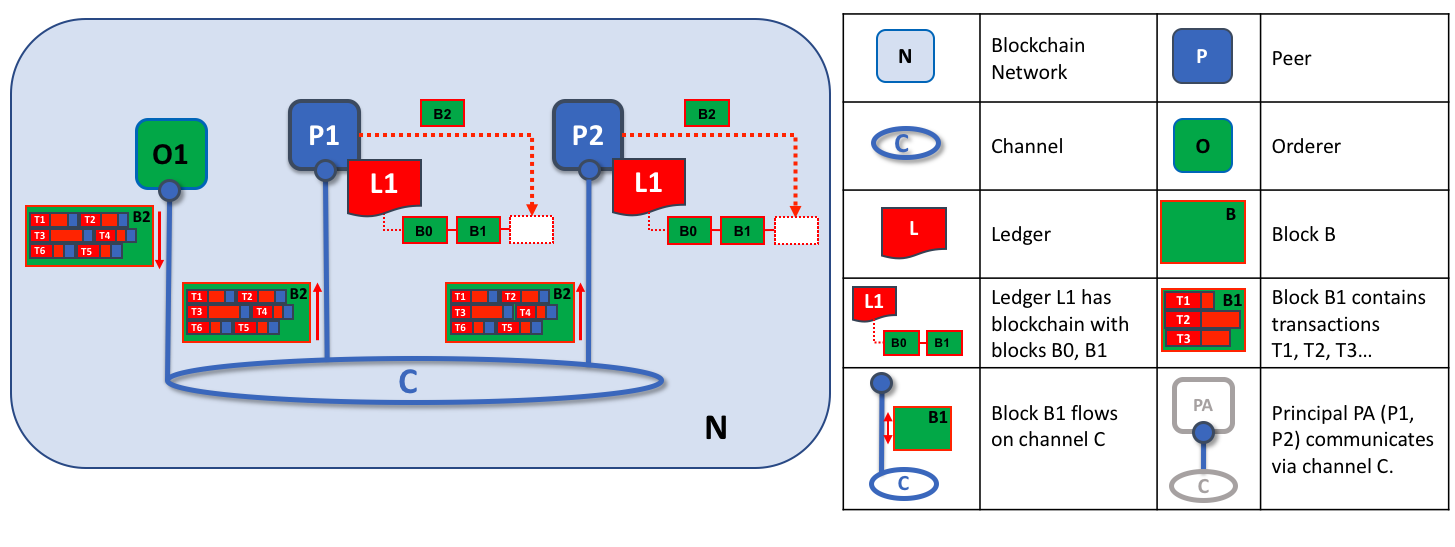 424 425 *The second role of an orderer node is to distribute blocks to peers. In this 426 example, orderer O1 distributes block B2 to peer P1 and peer P2. Peer P1 427 processes block B2, resulting in a new block being added to ledger L1 on P1. 428 In parallel, peer P2 processes block B2, resulting in a new block being added 429 to ledger L1 on P2. Once this process is complete, the ledger L1 has been 430 consistently updated on peers P1 and P2, and each may inform connected 431 applications that the transaction has been processed.* 432 433 Phase 3 begins with the orderer distributing blocks to all peers connected to 434 it. Peers are connected to orderers on channels such that when a new block is 435 generated, all of the peers connected to the orderer will be sent a copy of the 436 new block. Each peer will process this block independently, but in exactly the 437 same way as every other peer on the channel. In this way, we'll see that the 438 ledger can be kept consistent. It's also worth noting that not every peer needs 439 to be connected to an orderer --- peers can cascade blocks to other peers using 440 the **gossip** protocol, who also can process them independently. But let's 441 leave that discussion to another time! 442 443 Upon receipt of a block, a peer will process each transaction in the sequence in 444 which it appears in the block. For every transaction, each peer will verify that 445 the transaction has been endorsed by the required organizations according to the 446 *endorsement policy* of the chaincode which generated the transaction. For 447 example, some transactions may only need to be endorsed by a single 448 organization, whereas others may require multiple endorsements before they are 449 considered valid. This process of validation verifies that all relevant 450 organizations have generated the same outcome or result. Also note that this 451 validation is different than the endorsement check in phase 1, where it is the 452 application that receives the response from endorsing peers and makes the 453 decision to send the proposal transactions. In case the application violates 454 the endorsement policy by sending wrong transactions, the peer is still able to 455 reject the transaction in the validation process of phase 3. 456 457 If a transaction has been endorsed correctly, the peer will attempt to apply it 458 to the ledger. To do this, a peer must perform a ledger consistency check to 459 verify that the current state of the ledger is compatible with the state of the 460 ledger when the proposed update was generated. This may not always be possible, 461 even when the transaction has been fully endorsed. For example, another 462 transaction may have updated the same asset in the ledger such that the 463 transaction update is no longer valid and therefore can no longer be applied. In 464 this way, the ledger is kept consistent across each peer in the channel because 465 they each follow the same rules for validation. 466 467 After a peer has successfully validated each individual transaction, it updates 468 the ledger. Failed transactions are not applied to the ledger, but they are 469 retained for audit purposes, as are successful transactions. This means that 470 peer blocks are almost exactly the same as the blocks received from the orderer, 471 except for a valid or invalid indicator on each transaction in the block. 472 473 We also note that phase 3 does not require the running of chaincodes --- this is 474 done only during phase 1, and that's important. It means that chaincodes only have 475 to be available on endorsing nodes, rather than throughout the blockchain 476 network. This is often helpful as it keeps the logic of the chaincode 477 confidential to endorsing organizations. This is in contrast to the output of 478 the chaincodes (the transaction proposal responses) which are shared with every 479 peer in the channel, whether or not they endorsed the transaction. This 480 specialization of endorsing peers is designed to help scalability and confidentiality. 481 482 Finally, every time a block is committed to a peer's ledger, that peer 483 generates an appropriate *event*. *Block events* include the full block content, 484 while *block transaction events* include summary information only, such as 485 whether each transaction in the block has been validated or invalidated. 486 *Chaincode* events that the chaincode execution has produced can also be 487 published at this time. Applications can register for these event types so 488 that they can be notified when they occur. These notifications conclude the 489 third and final phase of the transaction workflow. 490 491 In summary, phase 3 sees the blocks which are generated by the orderer 492 consistently applied to the ledger. The strict ordering of transactions into 493 blocks allows each peer to validate that transaction updates are consistently 494 applied across the blockchain network. 495 496 ### Orderers and Consensus 497 498 This entire transaction workflow process is called *consensus* because all peers 499 have reached agreement on the order and content of transactions, in a process 500 that is mediated by orderers. Consensus is a multi-step process and applications 501 are only notified of ledger updates when the process is complete --- which may 502 happen at slightly different times on different peers. 503 504 We will discuss orderers in a lot more detail in a future orderer topic, but for 505 now, think of orderers as nodes which collect and distribute proposed ledger 506 updates from applications for peers to validate and include on the ledger. 507 508 That's it! We've now finished our tour of peers and the other components that 509 they relate to in Fabric. We've seen that peers are in many ways the 510 most fundamental element --- they form the network, host chaincodes and the 511 ledger, handle transaction proposals and responses, and keep the ledger 512 up-to-date by consistently applying transaction updates to it. 513 514 <!--- Licensed under Creative Commons Attribution 4.0 International License 515 https://creativecommons.org/licenses/by/4.0/) -->